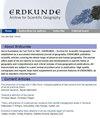The Chinafication of Hollywood: Chinese consumption and the self-censorship of U.S. films through a case study of Transformers Age of Extinction
IF 1.1
4区 社会学
Q3 GEOGRAPHY
引用次数: 4
Abstract
For Hollywood films, the international box office is now financially more important than the domestic market. China will soon become the world’s largest box office for Hollywood films. To gain access to the Chinese market foreign films must be approved by China’s government. Movies must not disparage Chinese culture, landmarks, or the government. Eager to comply, Hollywood producers are not waiting until they are reviewed to make changes and instead are self-censoring in advance rather than risk being denied access. In this paper, I use a representation-in-relation-to approach to cultural geography that positions a film’s text in relation to its production practices to understand the way Hollywood is remaking itself to appeal to China. The representation-in-relation-to approach takes practice seriously without jettisoning the power of representation. I apply this approach to Transformers: Age of Extinction, which through its production practices provides a case study on what trade publications are referring to as the ‘Chinafication of Hollywood.’ In an industry driven by profit, the Chinafication of Hollywood is a form of influence that further limits the creativity and uniqueness of Hollywood movies by prescribing what gets made and how it is represented. Transformers: Age of Extinction is an important cultural text, not for its narrative content, but for how its representation relates to the production practices that allowed it to become China’s largest grossing film at that time and the only billion-dollar blockbuster of 2014.好莱坞中国化:以《变形金刚4:绝迹重生》为例分析中国对美国电影的消费和自我审查
对于好莱坞电影来说,国际票房在财务上比国内市场更重要。中国很快将成为世界上好莱坞电影票房最高的国家。要想进入中国市场,外国电影必须得到中国政府的批准。电影不能贬低中国文化、地标或政府。急于遵守规定的好莱坞制片人并没有等到审查后才做出改变,而是提前进行自我审查,而不是冒着被拒绝访问的风险。在这篇论文中,我使用了一种与文化地理学相关的方法,将电影文本与其制作实践联系起来,以了解好莱坞如何重塑自己以吸引中国。与方法相关的代表性在不抛弃代表权的情况下认真对待实践。我将这种方法应用于《变形金刚:灭绝时代》,该片通过其制作实践,对行业出版物所称的“好莱坞中国化”进行了案例研究在一个由利润驱动的行业中,好莱坞的中国化是一种影响形式,通过规定制作内容和表现方式,进一步限制了好莱坞电影的创造力和独特性。《变形金刚:绝迹重生》是一部重要的文化文本,不是因为它的叙事内容,而是因为它的表现与当时中国票房最高的电影和2014年唯一一部价值10亿美元的大片的制作实践之间的关系。
本文章由计算机程序翻译,如有差异,请以英文原文为准。
求助全文
约1分钟内获得全文
求助全文
来源期刊

Erdkunde
地学-自然地理
CiteScore
2.00
自引率
7.10%
发文量
17
审稿时长
>12 weeks
期刊介绍:
Since foundation by Carl Troll in 1947, ''ERDKUNDE – Archive for Scientific Geography'' has established as a successful international journal of geography. ERDKUNDE publishes scientific articles covering the whole range of physical and human geography. The journal offers state of the art reports on recent trends and developments in specific fields of geography and comprehensive and critical reviews of new geographical publications. All manuscripts are subject to a peer-review procedure prior to publication. High quality cartography and regular large sized supplements are prominent features of ERDKUNDE, as well as standard coloured figures.
 求助内容:
求助内容: 应助结果提醒方式:
应助结果提醒方式:


